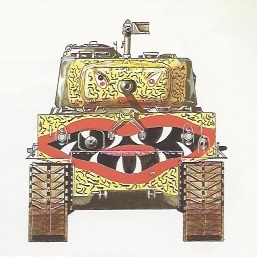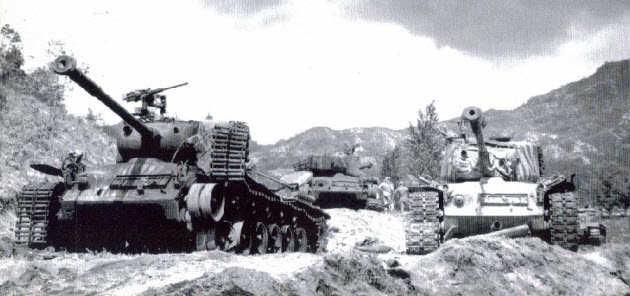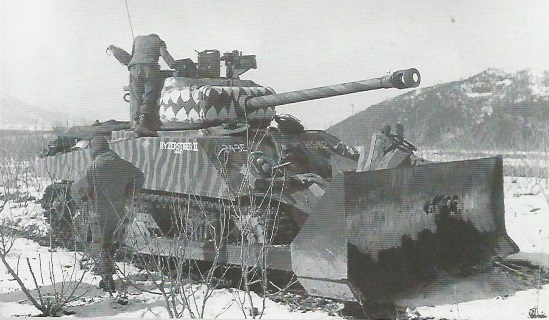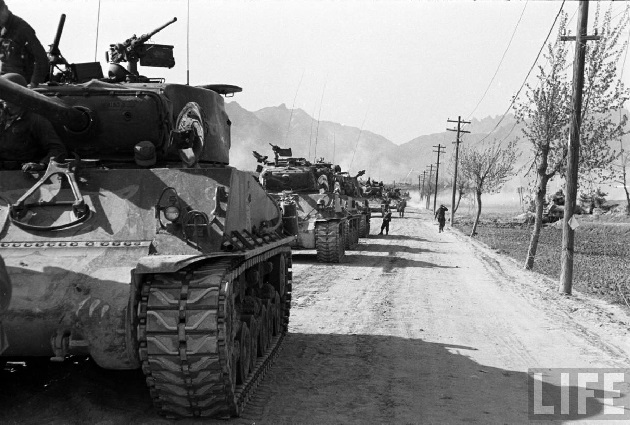Operation Ripper (6-31 March 1951) was a main UN offensive during the Korean war with the objective of liberating the South Korea capital Seoul and to force the communist forces back to the 38th Parallel. The Chinese did not have any tanks and the North Koreans lost most of their tanks during the fighting in 1950. The main threat was the Chinese massive human wave attacks which demoralized the US troops since the Chinese entered the war in October of 1950.
For this offensive, the US Army employed a bit of psychological warfare on the Chinese who were supposedly superstitious of tigers and dragons. According to the Chinese Zodiac calendar, the Tiger is considered to be brave, cruel, forceful, stately and terrifying, the symbol of power and lordliness. In ancient times, the Chinese people usually compared emperors or grandees with the tiger. To boost the moral of the UN troops and to instill fear in the Chinese, the US tank crews were instructed to paint their tanks with tiger heads/faces, bloody sharp teeth and claws. These schemes were the most elaborate colorful markings ever applied to US tanks.

This plan might not been as effective as expected due to some misinformation. The Chinese new year in 1951 was actually the end of the Year of the Tiger (17 February 1950 to 5 February 1951) and was the beginning of the Year of the Rabbit (6 February 1951 to 26 January 1952). Changing the images on their tanks to Bugs Bunny probably would not have been more effective.
After the offensive ended, the guise was no longer needed and the paint schemes were either faded from exposure or were over painted. In April 1951, the Chinese launched a counter offensive which retook most of the ground gained during Ripper but were not able to retake Seoul. The front lines then stabilized and armistice talks began on 10 July 1951 which dragged on for two years while the fighting continued. During this period, the UN tanks manned ridge top positions which provided fire support for infantry patrols in No man’s land and they became very effective at busting enemy bunkers along the front lines.
US 25TH INFANTRY DIVISION
89th Tank Battalion
These M4A3E8s carry one of the most elaborate schemes during the “tiger” period. The front hull and turret was painted tan and then hundreds of small green squiggles were hand painted over it to make a background for the eyes and a large leering mouth with red lips and sharp teeth.


Company C departed from the battalion’s standard scheme and adopted a more simplified devil motif on frontal armor of their tanks.

All the tanks in this company carried the name “Rice’s Red Devils” on the turret with the word “Red” painted in red on the turret star. The unit was named after it commanding officer, Captain Clifford Rice. Note the crude hand painted stars on this tank.


This M4A3E8 advances across a rocky field near the Han River.

This M4A3E8 just crossed the Han River near Unchon-ni. The lower half of the front hull appears darker because it is wet.

For the past six decades, all sources showed or indicated that the front hull was painted the standard Olive Drab. These photos could have been in private collections for all these years and were only recently released to the public.

It is possible that some tanks in the unit were painted in this scheme and it does makes logical sense since the devil is often envisioned as being overall red. But there is also the possibility that these photos were colorized.


79th Tank Battalion
Company A was the only company in the 79th Tank Battalion and was equipped with only M24 Chaffee light tanks. This was one of the first US armor units that was deployed to Korea after the breakout of the war in July 1950. The surviving M24s of this unit carried an unique simplified tiger face and the mouth was painted on the front hull.


See time segment 0:12 in this film: Korea: Han River (1951)
This M24 is driving through mountainous terrain south of the 38th parallel on 29 March 1951.

US 24TH INFANTRY DIVISION
6th Tank Battalion
M46 tanks of company A on the line at Yangpung prepare to fire on communist positions, 6 March 1951. The battalion’s tanks were numbered sequentially and had both .30 and .50 caliber machine guns mounted on the turret.

See time segment 7:20 in this film: Combat Bulletin No. 108 (1951)
Film: Korea War, Tanks: 187 RCT; 6th Medium Tank BN; 70th Tank BN
Warning: This film has a graphic hand wound scene.
It also shows a supporting Churchill Bridge layer tank from the British 29th Brigade.

North of Chongpyong on 2 April 1951, a M46 helps extract a platoon mate M46 from a muddy rice paddy. The M46 in the foreground has one of the early type muffler covers which does not extend all the way down the side of the muffler.


This M46 of second platoon, Dog Company, D-10, named “Dagwood” was knocked out on the night of 25 April 1951. The name most likely refers to the character from the 1930’s comic strip Blondie (later a radio show and several movies).
Here is more info on the crewman who survived – The Valley of Death

The left track this M46 was damaged by a mine and the tank is being recovered by a M26A1 tractor.

During a retreat in early April, these M46s were knocked out by enemy action. They were recovered later when the area was recaptured by elements of the 24th Infantry Division.

This early M4A3(76) VVSS equipped with a M1 dozer blade belonging to the HQ & Service Company, 3rd Combat Engineer Battalion, 24th Infantry Division. The tank was named “HYZER’S TIGER II” after the battalion commander, Peter C. Hyzer, and below it is the name “NANCY” painted in small white letters. Tiger stripes were painted around the hull and turret. It made sense to paint the teeth around the turret which made them visible over the dozer blade.

5th Regimental Combat Team (RCT) tank company
All the tanks in this company carried the tiger schemes except for the tanks in the 2nd platoon. The tanks carried Hawaiian names on their sides such as “Mona Loa”, “Aloha”, “Leilani” and “Hula Girl”.
4th Platoon, Tank 5:
Crew Left to Right:
Cpl John T. Clark (Union, SC)
Cpl James E. Kishbough (Nescopeck, PA)
Sgt Frank C. Allen (Etiwanda, CA)
Sgt Theodore R. Liberty (Bushton, MA)
and Cpl William J. Bohmback (Boston, MA)
prepare to advance along the Han River area, Korea.

This is my close up of the cast markings on the gun mantlet.
Do not look too closely into the eyes, the right one might fire back.

This is my close up of the cast markings on the inside of the hull machine gunner’s hatch. Click here for more information on Foundry Symbols and Trademarks

Below the mouth on the center of the transmission housing is a red pentagon which was the badge of the 5th RCT. The close up on the right shows a truck in the background and there is a tent immediately behind the tank.

This is supposedly another photo of the same tank above. This tank has a tow cable draped over the hull next to the driver’s hatch while the photo above does not have a tow cable. The soldier’s uniform indicates early spring or summer. If the tow cable was added later, then most likely it would not been painted. Also the mountains in the background probably would not be gray. Can you say “photoshop”?

US 7TH INFANTRY DIVISION
73rd Tank Battalion
Some of the M46s of the battalion were painted with colorful tiger heads and paws. The three bands on the gun barrel probably indicate the third company (c) along with the “C-22” painted on upper right edge of the glacis plate. This tank would also had a large white star painted on the engine deck. Note that the side track guard panels have been raised to hold additional storage in place.


This M46 carrying South Korean (ROK) troops prepares to cross the Imjin River to help secure a bridgehead. The two bands on the gun barrel probably indicate Company B.

A M32 lifts the turret off a M46 at the 2nd Ordnance Heavy Weapons Repair Shop in Yongdongpo. Note the name “BO-CATOR” on the front hull and the paws painted on the front fenders.

US 3RD INFANTRY DIVISION
64th Tank Battalion
The 64th was the only segregated African American tank battalion to see combat in Korea. Originally it was the 758th Tank Battalion which fought in Italy during WWII. After WWII, it was re-designated as the 64th Tank Battalion. The 64th arrived in Korea in November 1950 and in early 1951 de-segregation of the unit began. On 14 March 1951, US 3rd and ROK 1st Infantry Divisions supported by the 64th Tank Battalion liberated the city of Seoul.
This broken down M4A3E8 named “Skeeter Hawk” has tow bars attached to the front hull and it was just towed out of the Han River indicated by the ice build up on the side track guard.

The 64th Tank Battalion superimposed an elaborate tiger head over a blue and white diagonally striped square which was based on the shoulder patch of the 3rd Infantry Division.

The 64th Tank Battalion had a mixture of Shermans, M26s and M46s during the spring of 1951. This column of M46s is traveling along a road.

US 1ST CAVALRY DIVISION
70th Tank Battalion
The battalion fought throughout WWII in North Africa, Sicily, Normandy,
Siegfried Line, Hürtgen Forest, Ardennes and in Germany.
While most crews painted elaborate tiger faces on their tanks, some tanks in the battalion had a simpler silhouette painted which was either a primer coat for the face or the crew just lacked artistic talent.

See time segment 0:24 in this film.
Film: Sherman tank moves and a 57 mm recoil rifle
A M4A3E8 carries troops of the 1st Cavalry Division in the pursuit of retreating Chinese forces in the vicinity of Chipyong.

May 1951


This is my close up of the inside of the driver’s hatch with casting markings.

The crewmen are concern about something.

Note the first road wheel is missing its rubber and a number track links are damaged probably caused by a mine.

The name “BIG BULL” would indicate Company B. On the hull side is probably a variation of the battalion’s shield.


I like what you guys are up to also. Such intelligent work and reporting! Carry on the excellent works guys. I have incorporated you guys to my blogroll. I think it’ll improve the value of my web site 🙂
LikeLike
some genuinely fantastic info , Sword lily I observed this.
LikeLike
After study a number of of the weblog posts in your website now, and I actually like your manner of blogging. I bookmarked it to my bookmark web site checklist and shall be checking again soon. Pls try my web page as nicely and let me know what you think.
LikeLike
Would they of painted tiger faces on M26 Pershings? I have not seen a picture of one before.
LikeLike
Sources state the 64th Tank Battalion had a mixture of M4A3E8s, M26s and M46s during Operation Ripper but I never found a photo of a M26 or M26A1 with painted tiger face. By mid 1951 all of the M26s were replaced by M46s.
LikeLike
I’m truly enjoying the design and layout of your website. It’s a very easy on the eyes which makes it much more pleasant for me to come here and visit more often. Did you hire out a designer to create your theme? Outstanding work!
LikeLike
Paris –
Thank you for your compliment. This website (blog) is hosted at WordPress.com and its functionality is fixed but I selected the images, color scheme, fonts and added some available features (widgets) to my blog.
LikeLike
Wonderful blog! I found it while surfing around on Yahoo News. Do you have any suggestions on how to get listed in Yahoo News? I’ve been trying for a while but I never seem to get there! Cheers
LikeLike
Hi Mike.
Re: 5th Regimental Combat Team (RCT) tank company, I was wondering how far back does the yellow paint extends? Is there any photos from the side?
Andrew CHOY
LikeLike
Hi Andrew.
That is a question which I and many others have been seeking an answer to for many years. If I had or found a photo of the side I would had included it in my post. There are a few books which have color drawings of the side showing the tiger paint extending half way down the side of the hull stopping somewhere under the turret and some have it stopping before or under the driver’s hatch. Another question is did the paint scheme ended as a straight edge or did it faded out? Also in the books and on models, the background color varied anywhere from a bright yellow to a solid orange color.
LikeLike
thanks Mike. I remember building a Tamiya M4A3E8 decades back, inspired by the iconic box-art rendition of this tank but not skilled enough to draw the tiger face. Having now own a Tasca version of this tank, will try and build it and attempt the painting scheme!
LikeLike
Wow, superb blog layout! How long have you been blogging for?
you make blogging look easy. The overall look of your website is great, let alone the content!
LikeLike
You really make it seem so easy with your presentation but I find this matter
to be really something which I think I would never understand.
It seems too complex and very broad for me.
I’m looking forward for your next post, I’ll try to get the hang of it!
LikeLike
wow, awesome post.Thanks Again. Really Cool.
LikeLike
Hello there, just became aware of your blog through Google, and found that it is really informative.
I am going to watch out for brussels. I will appreciate if you continue this
in future. Lots of people will be benefited from your writing.
Cheers!
LikeLike
Hi there, I found your blog by means of Google even as looking
for a related subject, your web site came up, it looks great.
I have bookmarked it in my google bookmarks.
Hello there, just changed into alert to your blog
thru Google, and found that it is truly informative. I am gonna be careful for brussels.
I will appreciate in the event you proceed this in future.
A lot of other people will be benefited from your writing.
Cheers!
LikeLike
Hi Mike,
I loved this read- I did not realise the scale of which the tiger paint reached in the U.S forces.
I know its a big ask, but I was wondering where you sourced the information for this? Im trying to write an article regarding the paint schemes (and struggling, might I add). I believe this unique and insightful piece of military history needs to be celebrated and understood in the wider historical field.
Any help would be massively appreciated.
All the best,
Sam
LikeLike
Hi Mike,
The color photo of the ‘photoshoped’ tiger faced Sherman originates from a collection of photos by Arthur W. Brule that are published here:
ShoeBox Photos
I found this page back in 2013, and e-mailed the person who had originally made the website regarding a higher resolution version of that photo. In reply I got the version that now can be found around the web (at least I would assume this to be the source), as I posted it on Missing-lynx and Armorama with permission from the web admin. Mr. Brule sadly passed away while I had this e-mail contact with the admin, so the timing wasn’t right for him to try contact and re-scan the original slide to make a even better version.
Hope this helps to clear things up a bit concerning that photograph.
Best regards,
Erik
LikeLike
Thanks very much for this most informative piece. I am wanting to paint a 1/100 Sherman with tiger face and stripes. Now I know why it was done and have loads of inspiration.
LikeLike
Dear mikesresearch.com administrator, Keep the good content coming!
LikeLike